The Lost Art of ABM Follow-Up: Why Timing and Context Decide Everything in ABM Services for B2B
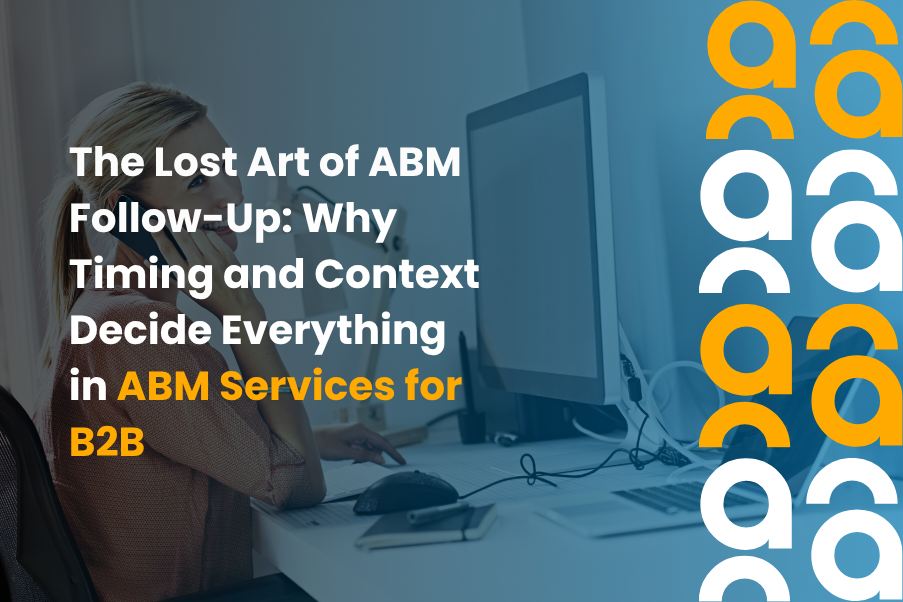
Introduction
You can have the cleanest tech stack, the most polished content, and a dream account list. But if your follow-up lands late or sounds like a template, your pipeline will feel like a ghost town.
That’s the part nobody brags about in ABM services for b2b, the quiet truth that timing and context decide who converts and who never replies.
Across every buying committee flooded with outreach, a well-timed, well-written follow-up is no longer a courtesy; it’s your strongest competitive edge. The difference between a closed deal and a cold lead often depends on what happens in those first 72 hours after engagement.
This blog reveals the hidden layer of ABM that turns campaigns into measurable revenue. You’ll see how top-performing U.S. teams use intent data, signal-driven outreach, and contextual follow-ups to win attention while others wait.
Let’s explore the lost art of follow-up and show how ABM services for b2b convert curiosity into pipeline, one precise touch at a time.
Why timing is not negotiable anymore
Buyers in the U.S. move more slowly on final approvals but faster on research. According to research by Forrester, on average, 13 people within an organization are involved in the buying decision, with 89 % of purchases involving two or more departments. That means short bursts of activity followed by long silences, and your timing during those bursts determines everything.
When intent spikes, your first follow-up should land within 24 to 72 hours. Wait longer, and your message fades behind competing conversations. Teams using ABM services for b2b that act within that window report higher meeting acceptance and faster pipeline movement.
This is how b2b account-based marketing performs when executed with urgency and precision. Quick, relevant outreach keeps your brand top-of-mind while the buying group is still evaluating options.
Context separates interest from action
Timing earns attention, but context keeps it. In b2b account-based marketing services, a follow-up that references what the account just did, downloaded a report, joined a webinar, or browsed a pricing page instantly feels relevant.
Here’s the difference:
- “Hey, saw you attended our webinar,” gets deleted.
- “Your VP of Demand joined our session on compliance-ready data pipelines; here’s how similar firms shortened review cycles by 32%” gets replies.
That’s the level of insight U.S. buyers expect. According to a report, 71% of marketers using signal-based ABM saw stronger ROI, while 40% integrated ABM directly with demand generation to build momentum faster.
This alignment proves that context makes your timing meaningful and transforms follow-up from routine to strategic.
The ABM follow-up mistake most teams make
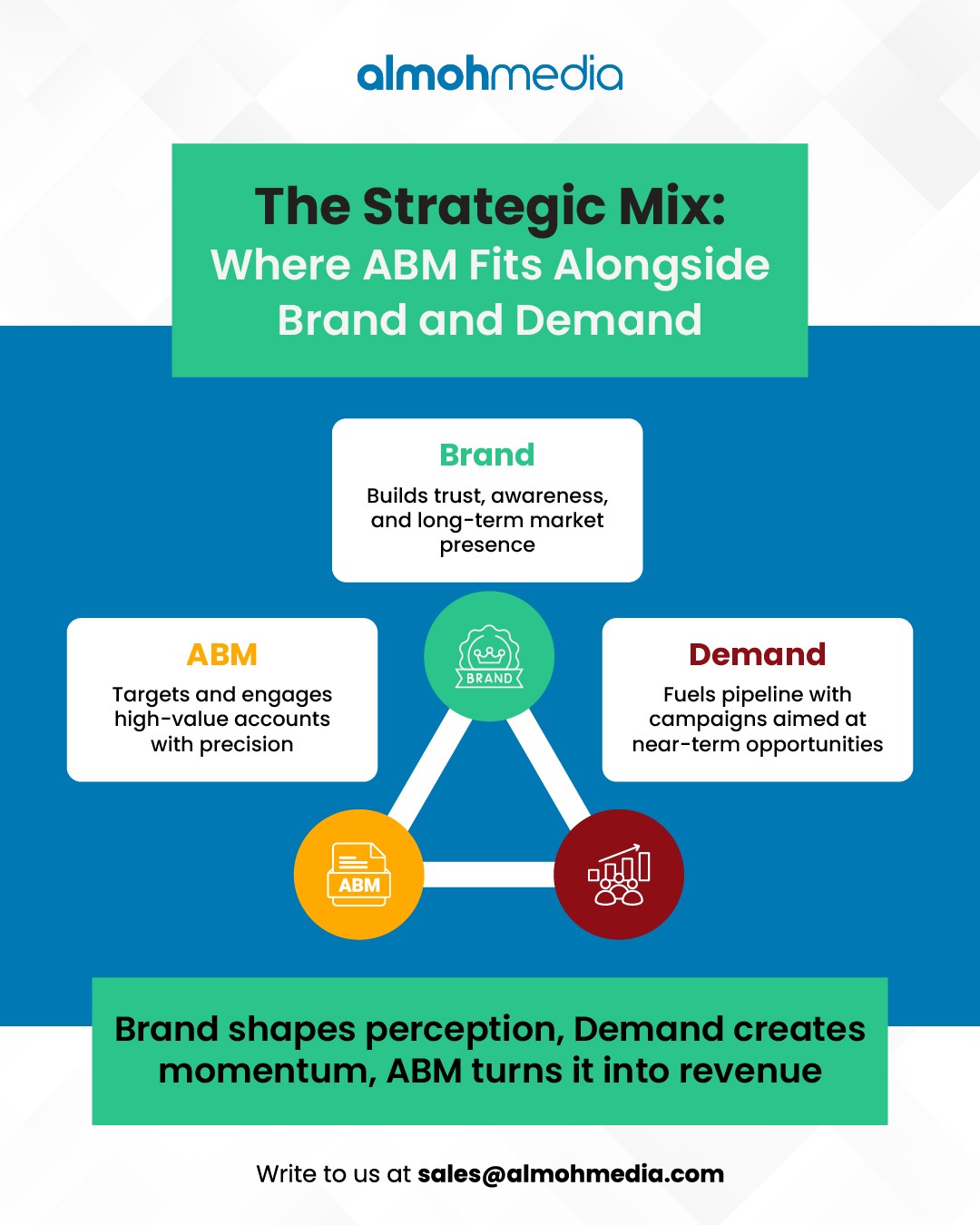
Many teams still treat ABM follow-up like a mass email. They run a sequence – Day 1 message, Day 4 reminder, Day 7 “circling back.” That rhythm works in generic B2B Demand Generation services but fails in ABM services for b2b.
ABM is beyond quantity; it’s about relevance and timing. And that’s where understanding account-based marketing types helps:
- One-to-one: Deep personalization for key strategic accounts.
- One-to-few: Targeted messaging for similar clusters.
- One-to-many: Scaled personalization across broader lists.
Teams that match their follow-up style to the correct ABM type maintain consistency without burnout. Almoh Media coaches clients to identify the type before launching campaigns so the effort fits the opportunity.
Learn more about why modern B2B teams prioritize meaningful engagement over mass campaigns – Smarter Growth with ABM Services for B2B.
Case study: turning cold leads into warm conversations
A U.S. enterprise tech brand partnered with Almoh Media to solve a common challenge: strong engagement, but weak follow-up conversions. Their SDR outreach sounded transactional and lacked context, leading to stalled conversations.
We rebuilt their follow-up process as part of our ABM services for b2b program. The solution included refining ICPs, routing leads based on behavioral signals, and crafting personalized outreach aligned with real buyer intent.
Within weeks, meeting conversions doubled and response rates rose significantly. The shift wasn’t about new campaigns but about sharper timing, contextual relevance, and alignment between marketing and sales.
For more insights on how Almoh Media drives high-intent engagement through ABM, read our related article: Intent-Based Data: A Key Ingredient for Effective B2B Lead Generation.
Practical ABM Follow-Up Framework
Different ABM programs need different follow-up rhythms. Here’s a quick breakdown showing how timing, context, and personalization shift across ABM services for b2b programs.
ABM Type | Response Time | Follow-Up Style | Personalization | Recommended Tools | Key Metrics |
One-to-One | Within 24 hrs | Direct, insight-led message referencing recent activity. | Very high | Salesforce, 6sense, LinkedIn Sales Navigator | Meeting rate, deal velocity |
One-to-Few | Within 48 hrs | Cluster-specific message with shared value points. | Moderate | Demandbase, RollWorks, Vidyard | Engagement rate, conversion by cluster |
One-to-Many | Within 72 hrs | Automated follow-up triggered by intent signals. | Light | Terminus, Metadata.io, HubSpot | CTR, content engagement |
This simple framework helps teams respond faster, personalize smarter, and measure follow-up impact at every ABM tier.
For deeper insights, explore this: Top Metrics to Measure the Success of B2B Account-Based Marketing Services
Smart tools amplify follow-up precision
Now let’s address tech.
The best account-based marketing tools help you see which people inside a target account are active, what they touched, and who else in that same company is now circling the problem. Teams frequently use platforms like 6sense, Demandbase, or RollWorks to identify buying signals across the entire committee, not just the first contact.
But tools alone do not fix weak follow-up.
Here’s the part leadership listens to. According to a 2024 report by Forrester, most ABM programs deliver 21 % to 50 % higher ROI than traditional marketing efforts, and about 23 % of firms reported ROI of 51 % to 200 % higher.
So, while tools inform decisions, timing and context execute them. Strong b2b account-based marketing services strike that balance daily.
What Almoh Media delivers
At Almoh Media, our ABM services for b2b help U.S. marketers connect timing, context, and activation:
- ICP development: We identify accounts with both need and budget alignment.
- Intent tracking: Real-time monitoring of website and content signals.
- Contextual outreach: Custom follow-ups based on role, pain point, and activity.
- Cross-team alignment: Marketing and sales operate from a shared account view.
- Reporting: Account-level dashboards showing movement, not vanity metrics.
Visit our Account-Based Marketing page for details on how we refine ICPs, GTM strategy, and outreach playbooks.
Closing thoughts
ABM fails most often not in targeting or creative but in follow-up. Timing earns the door, and context keeps it open.
When your sales and marketing teams share one storyline, act fast on intent, and use the best account-based marketing tools to stay ahead, you turn attention into opportunity.
Almoh Media’s ABM services for b2b help you master that moment. Let’s advance your follow-up rhythm, personalize with purpose, and convert engagement into consistent revenue growth.
Talk to us today and see how b2b account-based marketing services work when timing and context drive every touchpoint.
Introduction
If you’re using content syndication, chances are you see it as just another way to get your content in front of more eyes. That’s fine, but there’s a lot more hidden beneath the surface. When you allow its full potential, content syndication ROI can surprise you, and it doesn’t take much to shift perception.
Let’s look at fresh data, outline a winning content syndication strategy, and show how U.S. B2B teams can get real value from it. Let’s begin!
What Is Content Syndication?
At its simplest, content syndication means sharing your B2B content: whitepapers, case studies, blogs on someone else’s site or network. This can be paid or free. You expand your reach, tap into new networks, and generate visibility, often reaching audiences you’d otherwise miss.
Why ROI From Content Syndication Deserves a Second Look
1. Huge lead production for relatively low spend
According to recent studies, the average cost per lead with content syndication is around $43. That’s far lower than other tactics, so even moderate conversion rates can offer solid returns.
2. Fast pipeline growth
Some platforms report that customers see 300–500% return on investment within three years. That’s not fluff – it’s real pipeline growth.
3. Verified conversion tracking methods
With UTM tagging and targeted vendor reports, U.S. marketers can track everything from initial syndication click to closed deal.
4. Built-in trust and positioning
Syndicating through known sites can give you indirect credibility, boosting brand awareness and authority without extra effort.
B2B Content Syndication Strategy: How to Do It Right
A good content syndication strategy starts long before content hits a third-party platform:
a). Pick assets that matter
Whitepapers, case studies, and long-form guides work best. They not only attract interest but also help establish your brand as industry-relevant.
b). Target lead quality, not rush volume
Instead of chasing clicks, target professionals. For example, top B2B firms average a 5.31% conversion rate on syndication offers.
c). Tag everything with UTM links
Measure traffic, engagement, bounce rates, and conversions back at your URL. This helps with syndication attribution.
d). Track core metrics
- CPL (cost per lead)
- MQL-to-SQL conversion rates
- Revenue per lead (use your average contract value)
e). Use the ROI formula
ROI= Revenue−Spend
Spend
For example, $1,000 spent → 50 high-quality leads → $5,000 average value = ($250k – $1k)/$1k = 249× ROI.
f). Optimize, rinse, repeat
Check what works by audience, site, and format. Then double down and drop what doesn’t.
Concrete U.S. ROI Stats You Can’t Ignore
| Metric | Statistics/Insight |
| Cost per lead | $43 average CPL |
| Syndication conversion rate | ~5.31% typical |
| Lead-to-deal conversion lift | 45% increase when focus is on quality |
| ROI over 3 years | 300%–500% reported |
| Projected industry growth | From $4.7 B in 2022 to $5.9 B by 2030 |
Content Syndication for Lead Gen: A Step‑by‑Step Plan
1. Define your ideal audience
Use buyer personas: titles, sectors, company size – so your content finds the right hands. This way, a sharper audience focus helps eliminate wasted spend and improves downstream lead quality.
2. Pick content with substance
Original research, how-to guides, competitive whitepapers – these both educate and convert. Plus, assets that solve specific problems tend to drive stronger engagement and more intent-driven leads.
3. Choose partners wisely
Use third-party platforms to reach U.S. B2B audiences. Look for those offering clear lead reporting and media kits. Before moving forward, ask for case studies or past performance metrics to make a more informed decision.
4. Structure campaigns with UTM tags
Make distinct tracking links for each partner and asset. This makes sure it’s easier to attribute leads, identify top performers, and compare ROI across channels.
5. Launch and monitor
Track CPL, CPL-to-SQL, cost per opportunity, pipeline driven, and revenue tied. At the same time, monitor activity in real-time to catch early trends and shift strategy fast if needed.
6. Review and refine monthly
Use metrics to shift spend toward top performers and tweak underperformers. As a result, consistent optimization keeps your syndication efforts aligned with revenue goals, not just vanity metrics.
How to Calculate Content Syndication ROI
- Calculate total spend (vendor fees + internal costs).
- Count total leads.
- Multiply leads by average deal size for potential revenue.
- Apply the ROI formula:
Revenue−Spend
Spend - Compare ROI over time to benchmark your initiatives.
This method is backed by multiple calculators and case studies.
Hidden Content Syndication Benefits
- SEO gains: Backlinks from quality sources can raise domain authority.
- Brand authority: Recognition on respected sites = credibility.
- Extended content life: A blog post can live on for months if syndicated well.
- Nurture acceleration: Leads from syndication are often further along in buying cycles.
Mistakes to Avoid and Fix Fast
Mistake: Only tracking clicks, not deals.
Fix: Tie every lead back to conversions with CRM integration. That way, you get a clearer picture of what’s actually driving revenue, not just traffic.
Mistake: Focusing only on cheap volume.
Fix: Go after quality; MQL-to-SQL rates matter most. Otherwise, your sales team will waste time on leads that won’t convert.
Mistake: Publishing irrelevant content.
Fix: Audit content – ensure tone, relevancy, and depth match syndication partner audiences. In doing so, you increase the chances of your content resonating with the right decision-makers.
Mistake: Not optimizing over time.
Fix: Regular performance review. Cut poor performers, boost winners. Over time, this helps improve ROI and keeps your content syndication strategy focused and results-driven.
Why Lead Quality Beats Volume
Not all leads are created equal. A smaller batch of high-intent leads can drive more revenue than a huge pool of low-interest ones.
Many B2B brands in the USA are shifting toward account- based syndication, where campaigns are matched to specific industries or companies. This helps improve conversion rates, shorten sales cycles, and increase customer lifetime value.
In short, prioritizing lead quality helps improve the long-term content syndication ROI, especially when targeting high-ticket accounts.
How AI Is Shaping the Future of Syndication
AI tools are starting to reshape content syndication strategy by analyzing behavior patterns and automating placements across high-performing channels.
With predictive scoring, marketers can now:
- Match content formats to individual user segments
- Forecast lead readiness using engagement scores
- Automate syndication at scale using content intent data
These innovations are raising the ceiling on what’s possible for B2B content syndication, especially for companies focused on measurable results.
About Almoh Media
Use metrics to shift spend toward top performers and tweak underperformers.
As a result, consistent optimization keeps your syndication efforts aligned with revenue goals, not just vanity metrics.
At Almoh Media, we specialize in high-impact content syndication for lead gen. We help B2B companies in the U.S. grow their pipelines by delivering:
- Verified lead generation from trusted channels
- Industry-specific targeting and campaign setup
- Transparent reporting tied to your sales funnel
- A proven strategy backed by real ROI
We understand the U.S. B2B buyer journey, and our syndication campaigns are built to generate demand, not just clicks.
Final Takeaway
Content syndication is an easy win if done smartly.
Focus on:
- Quality, not just volume
- Clear tracking and attribution
- Lead-to-deal conversions
- Continuous optimization
With $43 CPL, 5+ percent conversion, and long-term returns of 300–500%, most U.S. B2B teams can justify putting more budget behind it.
Ready to Get Real ROI from Content Syndication?
Let Almoh Media help you build a smarter lead-gen machine. We bring strategy, scale, and precision to content syndication – so your campaigns don’t just get seen; they convert. Reach out now to get started.
-
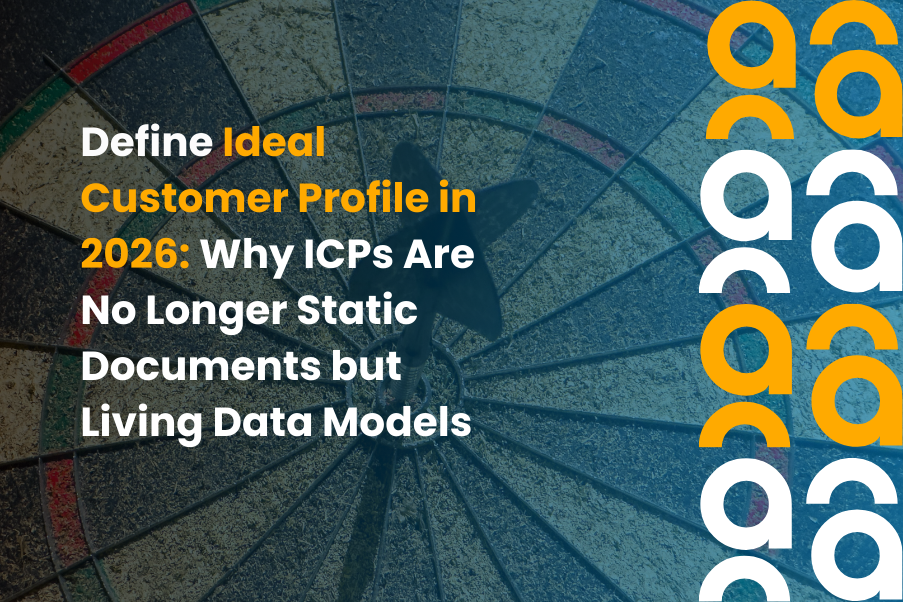 Define Ideal Customer Profile in 2026: Why ICPs Are No Longer Static Documents but Living Data Models
Define Ideal Customer Profile in 2026: Why ICPs Are No Longer Static Documents but Living Data Models -
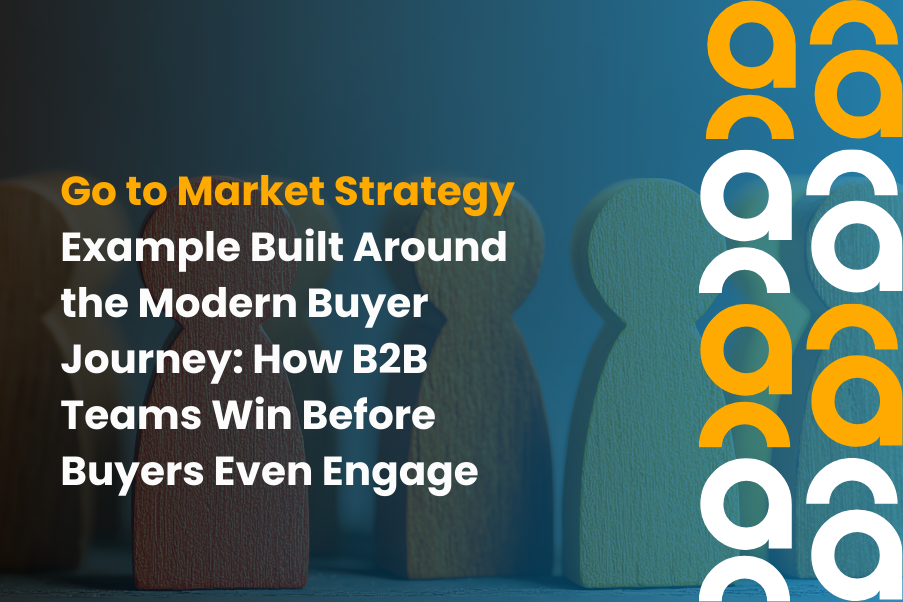 Go to Market Strategy Example Built Around the Modern Buyer Journey: How B2B Teams Win Before Buyers Even Engage
Go to Market Strategy Example Built Around the Modern Buyer Journey: How B2B Teams Win Before Buyers Even Engage -
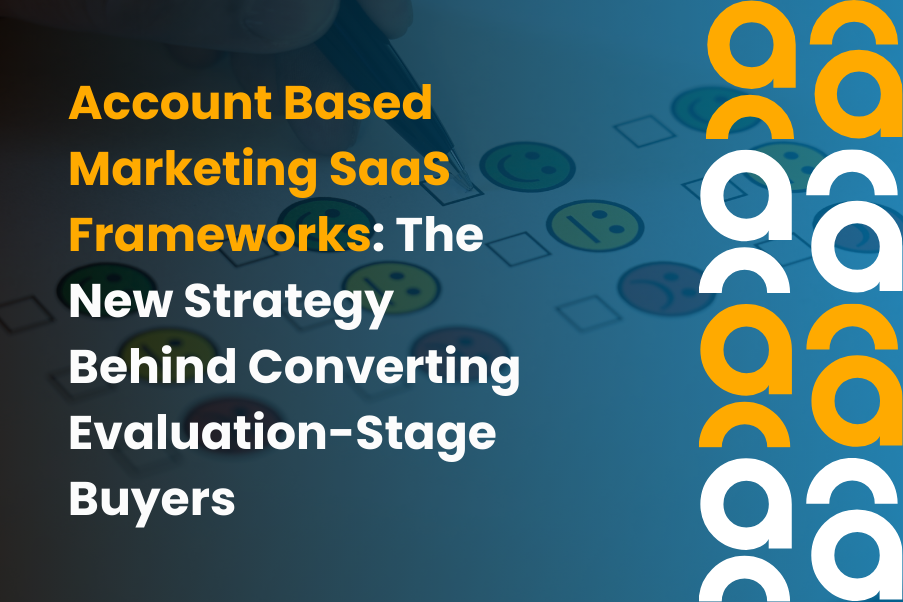 Account Based Marketing SaaS Frameworks: The New Strategy Behind Converting Evaluation-Stage Buyers
Account Based Marketing SaaS Frameworks: The New Strategy Behind Converting Evaluation-Stage Buyers -
 What 2026’s Best-Performing Teams Do Differently when it comes to B2B Account-Based Marketing Campaigns
What 2026’s Best-Performing Teams Do Differently when it comes to B2B Account-Based Marketing Campaigns -
 B2B Account Based Marketing in an Over-Messaged World: The Rise of Context-First Personalization
B2B Account Based Marketing in an Over-Messaged World: The Rise of Context-First Personalization

